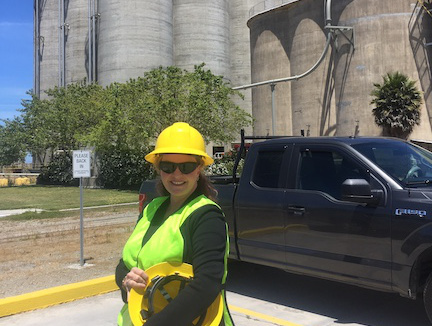The Port of Redwood City’s success in persuading the U.S. Army Corps of Engineers (USACE) to provide annual dredging of the port’s ship channel will enhance revenues and tonnage according to Kristine Zortman, executive director, Port of Redwood City.
Previously, the ship channel was only dredged once every two years resulting in major silting in the off years that reduced the loaded draft that vessels could safely transport to and from the Port. This resulted in decreases of shipments of both building materials and scrap metal that transit through the port’s facilities.
Zortman, who has campaigned for the annual dredging change for several years, hailed the support of the Port’s maritime stakeholders and partners:
“It was really bringing together all of our stakeholders and port partners to educate the U.S. Army Corps of Engineers, … on the staff and division level as well as at headquarters. I could not do it alone. We had our tenants, Cemex Aggregate, Sims Metal Management, and others including the San Francisco Bar Pilots supporting us. We had probably 25 port partners at a meeting with the U.S. Army Corps of Engineers, Lieutenant Colonel Kevin Arnett, Commander San Francisco District, as well as Colonel Antoinette Gant, South Pacific Division Commander.”

“In the meeting, we talked about the economic impacts when we lose two feet, four feet, and last year when we lost six feet of ship channel draft due to silting … That was what we were able to inform the Corps district staff so as ... to do the analysis for a recommendation to switch to annual dredging.”
Zortman said: “The annual dredging will start in fiscal year 2023, which means some time next year. Last year, Curtin Maritime did a fabulous job on the dredge, and it seems that some of the over dredge and over excavation helped hold some of the slopes where they needed to be held. So, we’ve got to get through this season before next year’s dredge.
She hopes the accelerated dredging schedule will boost tonnage: “Right before the Pandemic, we were at 2.5 million tons of cargo per year, and we hope to get back to that number with the annual dredging …
She says there are projections for an increase in shipments of building materials and recycled materials based on “conversations we’re having with our port partners … looking at private sector contracts for building materials. We’re also seeing a significant increase in recycling which continues to remain a strong market for us.”
In addition, Zortman said the Port needs the maximum draft to support its role as a federal emergency staging area: “We are a FEMA (Federal Emergency Management Agency) federal emergency staging area. And if you lose six feet in your channel and, heaven forbid, there is a catastrophic event and you’ve got to deploy first responders and resources you’ve got to assess how you’re about to deal with a restriction on the channel if you need to bring in vessels with a lot of supplies, fuel, and other important items.”
Revenues Up, Tonnage Down In 2021
The Port of Redwood announced that the fiscal year 2021 closed positively with $9 million in gross revenue. Property rental, leases and new business lifted the Port’s gross revenue and contributed to an increase of 3% or $270,000, compared to the previous fiscal year of $8.7 million. However, the Port’s total cargo tonnage decreased to 1.8 million metric tons, which was a 291,000 MT reduction from the prior fiscal year’s tonnage. This was due to impacts associated with the continued COVID-19 pandemic. Port tenants and their operations have weathered the pandemic and all indicators within the global supply chain remain strong for both the construction industry and well as the recycling needs of the Silicon Valley region.
Upgrading Route 84 Interchange With 101 Freeway
Zortman said: “We been working with our port partners on improving the State Route 84 interchange with the 101 freeway … when it was built, we weren’t doing an average of 2 million metric tons a year. We also do an average of 2 million metric tons of cargo via rail a year. So, improvements on that interchange would not only improve the truck access in and out of the Port, but it would also make rail improvements for cargo going in and out. So, this improves trucks getting in and out without significant idling and greenhouse gas emissions. We are working with our agencies to see what types of grant monies are available to assist in the $115 million that has already been committed towards that project. There is an additional $184 million dollars needed to complete it. Fortunately, the Environmental Impact Report was completed in 2016.”
Future Ferry Terminal
“We’re finishing up the business plan for the future ferry service and that’s in partnership with the Water Emergency Transportation Authority. We anticipate that plan will be complete in a June timeframe. And that will go to the San Mateo County Transportation Authority for their review.” Ferry service would link the Port of Redwood City with San Francisco and the East Bay.
Redevelopment
“We have issued a Request for Proposal (RFP) for our commercial recreational waterfront for redevelopment opportunities there. … there is a need for us to elevate the Port’s profile with destination type uses. This includes … restaurants … or museums in there and there is an opportunity for hotels. “
Commercial Fishing
“We had to start thinking outside the box on other types of opportunities to get people down to the waterfront. We were successful in getting our first commercial fishermen from San Francisco’s Fishermen’s Wharf, Pioneer Seafoods, that elevated the Port’s profile.”

